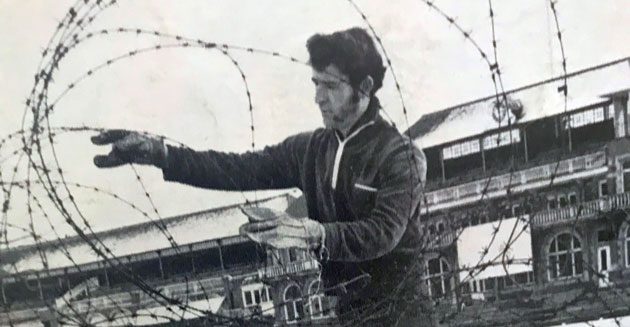Half a century ago, Ray Illingworth’s England side were engaged in a fierce battle against the world’s best, led by Garry Sobers.
Yet for many months it had seemed Surrey would be engaged in a fight to keep people out of the The Oval rather than inviting them in.
Richard Spiller explains, with the help of groundsman Bill Gordon and Sir Geoffrey Boycott, on whom so much depended if England were to score runs.
Barbed wire around The Oval is a sight we associate with the days when the ground had been converted into a prisoner-of-war camp during the Second World War.
The Germans for whom the accommodation was intended never arrived yet the ground got near to a military footing again in 1969-70.
A debate about whether England should maintain links with South Africa, in the grip of the apartheid regime, had been rumbling for many years. It exploded in 1968, when the selection of Basil D’Oliviera – not allowed to compete for a place in his own country, being Cape Coloured, and having moved to England – for a tour there provoked South Africa’s hardline Prime Minister John Vorster to declare the party unacceptable.
Despite that, plans remained for the next scheduled series in England in 1970, a tour which looked increasingly unlikely when matches the previous summer involving some of the best young South African players – including Mike Procter and Barry Richards in a party organised by businessman Wilfred Isaacs – were disrupted by protesters.
More ominous still, for the substantial proportion of those involved in English cricket who still hoped that the series would still take place and believed that sport and politics should never mix, was that the 1969-70 visit to Britain by the Springbok rugby side provoked massive protests and disruption.
Could cricket be played in such an atmosphere? Peter Hain and his Stop The Seventy Tour group believed not and there were many who agreed with them, among them the former England captain David Sheppard.
South Africa had many links with the hierarchy of English cricket, though, and there was an desire to see the best team in the world – having just thrashed Australia 4-0 – among cricket followers..
Through the winter and spring, the debate became increasingly heated, Harold Wilson’s Labour government urging the Cricket Council to call off the tour but not wishing to go so far as to order its cancellation, particularly as they were building up towards a general election which would take place in the summewr.
A shortened tour programme had already been arranged, with security issues in mind, involving Tests at Lord’s, Trent Bridge, Edgbaston, Headingley and The Oval.
But how could the grounds ensure they not suffer the same sort of sabotage occurring at rugby venues?
Bill Gordon, who had joined the groundstaff in 1964 and remains at the club as the pavilion curator, remembers Geoffrey Howard – the club secretary and a man with a visceral hatred of apartheid – calling a staff meeting.
“He asked for any ideas. Several were put forward and one was to surround the entire square with barbed wire,” recalls Gordon.
As usual, Howard had already been thinking it through: “He recommended that an artificial pitch be laid in case the square was damaged.”
“We had a few messages that total weed killer would be used, so if the tour did go ahead the artificial pitch would come into play.”
That meant head groundsman Ted Warn had to remove one of the pitches in the centre of the square, replacing it with an artificial surface which had coir matting on top.
And that also meant someone had to keep watch – a job which fell on the busy groundstaff as well: Gordon says: “A cararvan was placed in front of the pavilion and we did shifts on night security.
“It was certainly a very testing few months.”
Eventually the pressure told, the threat of serious civil unrest matched by an acceptance that it would be impossible to play cricket in such a climate. Division was rife. Some players – such as Surrey’s Younis Ahmed and Intikhab Alam, announced that they would not be available to play against South Africans in tour matches. Leading broadcaster John Arlott told the BBC he would not commentate on the series and in the Daily Telegraph their cricket correspondent EW Swanton was in favour of calling it off while editorials thundered that it should go ahead.
West Indies players contracted to counties were warned by pressure groups in the Caribbean that taking part in matches would have repercussions.
When the Cricket Council decreed on May 19 that the tour should go ahead but that it would be the last time South Africa would be allowed to choose an entirely white team, effectively having a bob both ways, that satisfied no one.
A day later Home Secretary James Calllaghan called in the administratorrs and told them that the government had come to the conclusion “on the grounds of broad public policy” they should tell the South Africans that they were no longer welcome.
That caused yet more political uproar but at least it solved the issue once and for all.
Now, though, came another problem and one which echoes this year. A summer without international cricket horrified both administrators and followers, even though the TV deal brought in shillings compared with the multi-millions of pounds nowadays. Gate receipts and exposure of the game were vital.
A series against Rest of the World was rigged up – still involving the cream of the South African side but given respectability and a huge boost in quality by the addition of some of the finest cricketers of their time.
While there was consternation among counties who stood to lose the services of their overseas players, demanding compensation, what emerged was one of the strongest and most glamorous touring teams to be seen in England.
It was led by Garry Sobers – the finest all-rounder in the world then and probably ever – but he had no interest in a series of exhibition matches. The series was awarded Test status, a decision which remains controversial to this day. He would be accompanied by several members of what would have been the South African touring side – Richards, Procter, Graeme Pollock and Eddie Barlow – plus West Indians Clive Lloyd, Rohan Kanhai, Dereck Murray and Lance Gibbs, Indian wicketkeeper Farokh Engineer plus Pakistani pair Mushtaq Mohammed and Intikhab.
Guinness agreed to sponsor the series and the itinerary for the South African series was retained.
England were led by Ray Illingworth, who had taken over the captaincy a year earlier when Colin Cowdrey snapped his achilles tendon, although plenty among the establishment wanted the Kent skipper back in charge by the forthcoming Ashes tour.
A walkover seemed likely when RoW won the opening Test by an innings and 80 runs at Lord’s although Illingworth was the highest scorer by some distance for his side, making 63 and 94. It was no disgrace to have been outshone by his opposite number Sobers, who took 6-21 in the England first innings and followed it by stroking 183.
Illingworth also made 97 when the hosts struck back impressively to win by eight wickets at Trent Bridge, aided by a Brian Luckhurst century, which meant tons from Lloyd and Barlow were in vain.
RoW went back in front at Edgbaston, by five wickets, and then sneaked in by two wickets at Headingley, aided by four wickets in as many balls from Barlow.
That match had seen the return to the England side of Geoffrey Boycott at the top of the order, having had an uncharacteristically moderate start to the season, making 64 in the second innings, and staying in the side for the final match at The Oval.
England’s 294 all out, Cowdrey top-scoring with 73, was only overtaken with the help of a glorious fifth-wicket partnership between Pollock (114) and Sobers (79), both victims of Lancashire seamer Peter Lever as he marked his debut by claiming 7-83.
While Boycott’s opening partner Luckhurst suffered the misery of a pair, the Yorkshireman confirmed his surge of form by cracking 157 in six and a quarter hours, an innings which earned him the Walter Lawrence Trophy for the “most meritorious innings of the series”.
But he lacked support other than from Keith Fletcher (63), departing at 289-6 and England were all out for 344 which left RoW needing 284 to wrap up the series 4-1.
This time it was Kanhai who proved the star with 100, Lloyd making a vital 68 but Sobers having the final word as his unbeaten 40 wrapped up victory by four wickets.
Boycott – now Sir Geoffrey – remembers the match fondly but with one note of disappointment: “When I got out I knew we were probably going to be 20 or 30 short of what we needed. It was a really good pitch because it hard bounce and carry and then it turned towards the end.
“They had Sobers and Mike Procter creating footmarks and that gave us something for the spinners to bowl into.
“I’d asked to be left out of the first three Tests because of my form but that hundred really set me on my way.
“Man for man we were outclassed by Rest of the World in that series, who were packed with all the best players, but it was a far more even series than the final margin. The win at Nottingham was a great performance and it set us up very well. Peter Lever’s bowling at The Oval was a fantastic effort.”
Sir Geoffrey was the dominant batsman the following winter, England under the canny Illingworth winning the Ashes for the first time since 1958-59, and then he averaged more than 100 in 1971.
That decision to grant the matches Test status was to be reversed later, also removing it from Australia v Rest of the World in 1971-72 and while Sir Geoffrey agrees, he has a quibble: “Making those matches unofficial is one thing but the ICC then gave Test status to Australia v Rest of the World in 2005 because it was making money for them.
“Well they can’t have it both ways.”
It is no surprise that The Oval has a special place for him, having scored his maiden Test century there in 1964, another in 1979 and then a third in the Ashes finale of 1981.
“It was a successful ground for me although I missed a few Tests there, thanks to injuries. And selectors!”
If you want to read more about the events of 1970, read Colin Schindler’s recently published book ‘Barbed Wire and Cucumber Sandwiches’.










